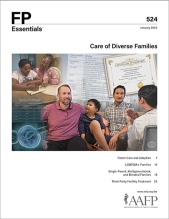
This clinical content conforms to AAFP criteria for CME.
Approximately 29% of LGBTQIA+ (lesbian, gay, bisexual, transgender, queer/questioning, intersex, asexual/agender, and other orientations/identities) adults are raising a child, and 2 to 3.7 million children have an LGBTQIA+ parent. These families often experience challenges. Social challenges include exclusion and homophobic hostility directed at the child and/or family. Medical challenges include difficulty finding clinicians who provide a welcoming environment, and dealing with clinicians who do not understand LGBTQIA+ issues. Physicians can help address those challenges by examining their implicit biases and by making changes in their offices and interactions with patients that make patients feel more welcomed. Other concerns relate to LGBTQIA+ children and adolescents, who often experience rejection and abuse by peers, likely contributing to higher rates of suicide. In addition, many youth feel discordance between their gender identity and their assigned birth sex, with some not feeling fully male or female (gender diverse) and others identifying as a gender opposite their sex assigned at birth (transgender). These individuals often experience gender dysphoria, and counseling can help. For some, there is an option to undergo hormone treatments to delay puberty until they have affirmed their gender identity. Others will want hormone treatments to transition to the gender they identify with.
Case 2. KT is a 10-year-old child whose mother brings him to your office for a well-child visit. His mother tells you that she has seen KT dressing up in skirts and high heels recently, and she is concerned about what this means. She and her husband come from what they consider “traditional” families in which boys are expected to be “masculine,” not wear girls’ clothing.
Subscribe
From $350- Immediate, unlimited access to FP Essentials content
- 60 CME credits/year
- AAFP app access
- Print delivery available
Edition Access
$44- Immediate, unlimited access to this edition's content
- 5 CME credits
- AAFP app access
- Print delivery available
